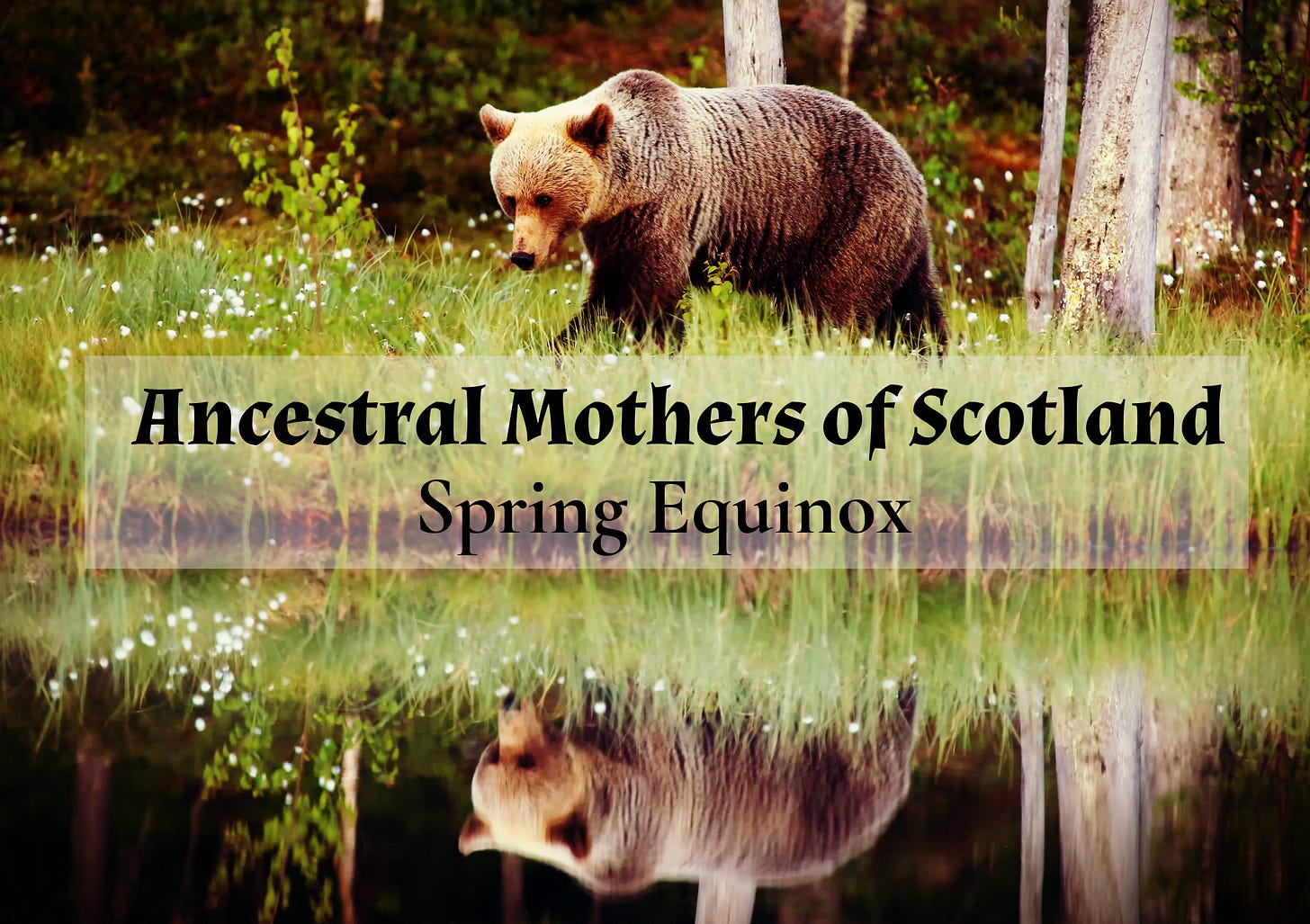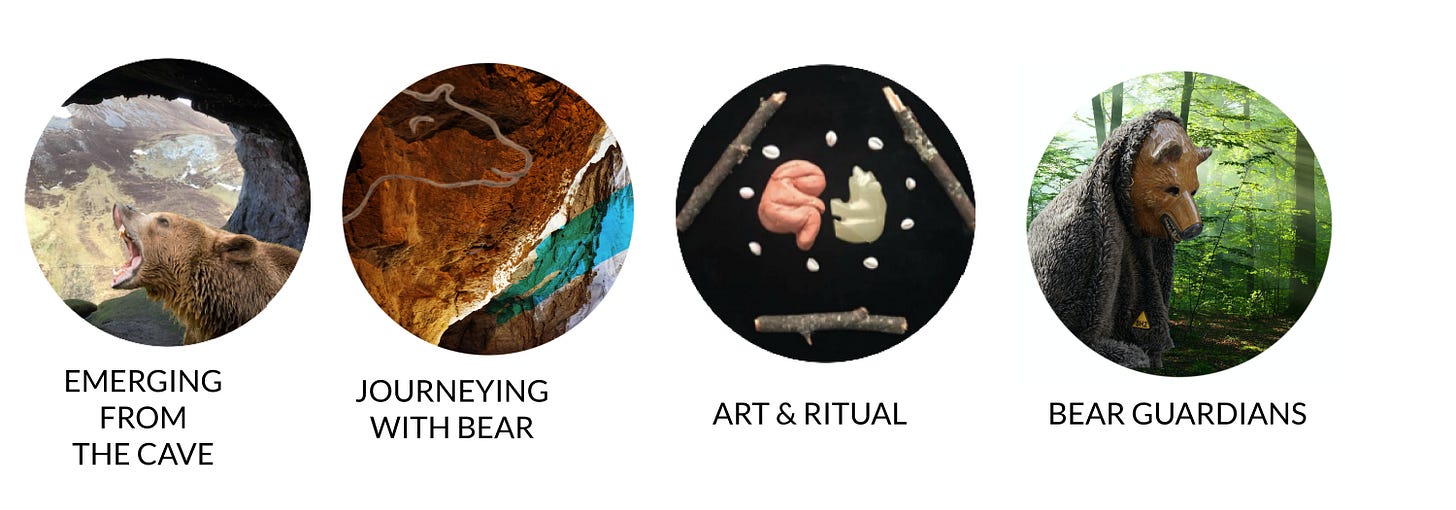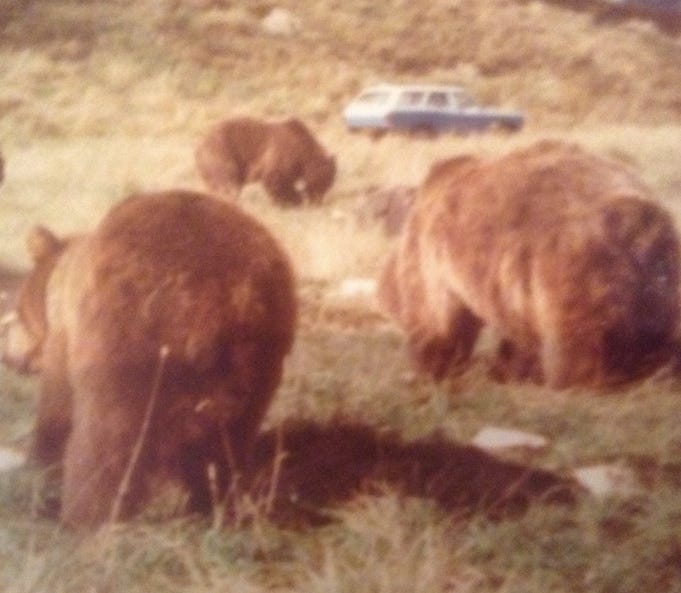Spring Equinox offerings:
Emerging from the Cave - The figure of Bear emerging from hibernation and a powerful symbol of the decent and return story
Journeying With Bear - The story of Breejah, Bear priestess, and the rites of emerging from the Cave of the Grandmothers
Art & Ritual - Making an oracle doll - acknowledging what remains in the cave and what we embrace as we return to the world
Bear Guardian - Indigenous peoples honoring bear and what we can do to help Bears around the world
Click on the image above for a recap of the journey of the Ancestral Mothers around the wheel of the year
Emerging from the Cave
To our ancestors, the bear wasn't just a biological entity, she represented both the physical and magical qualities they observed. She was a wise teacher and a loving mother who was fiercely protective of her young. Each fall ancient peoples observed the bear going into hibernation and yet in the heart of winter she would have appeared dead, her heartbeat slow and her breathing barely noticeable. To observe the same bear, coming back from the dead in
spring would suggest magical powers, that she was a communicator with the otherworld.
Emerging from the dead bearing new life in the form of cubs, she also emerged bearing life to the land itself. She breathed life into the dead of winter, which lost its grip as the stirrings of spring radiated throughout the soil. All of these qualities fed our ancestor's spiritual beliefs, creating myths and rituals, and practices to live by which also marked the great cycle of the seasons.
Archeologist Maria Gimbutas unearthed what may be evidence of bear cults in the form of figurines, possibly representing the bear as a birth goddess. Small figurines from Eastern Europe 5,000 BCE called 'bear nurses' depict human figures wearing bear masks. Similarly 'bear madonnas' figures dating from 6,000 BCE depict human female figurines wearing a bear mask while holding a bear cub.
In European folk memories, the bear is an ancestress, a divine birth-giving mother and protectress. The practice of a grandmother placing a newborn baby on a bearskin, described in the 3rd century AD by Porphyry, was continued in Slavic lands into the 20th century. The Bulgarians held ritual feasts for “Grandmother Bear” as did the Belorussians, who associated the bear with healing powers, fecundity, and prosperity. Linguistic evidence connects the bear with the ability to give birth, as in the Old European root bher-, Germanic *beran ‘to bear children’, ‘to carry’, Germanic *barnam, ‘child’, and Old Norse burdh, ‘birth’.
In eastern Lithuania, a woman who has just given birth was traditionally called Meška ‘Bear’. When the new mother approached the sauna for a ritual bath some weeks following the birth, the women preparing the ritual would call out, “The Bear is coming, the Bear is coming,” suggesting a remnant of an archaic ritual formula.
Marler, J & Harald Haarmann, H. "The Goddess and the Bear Hybrid Imagery and Symbolism at Çatalhöyük" in Journal of Archaeomythology vol. 3 (Spring/Summer, 2007) 48-79.
Bears at the Loch Lomond Bear Park
Growing Up with Bears
The bear was most likely the first figure humans honored the descent of the dark of the year with and the eventual return at Spring Equinox. This descent was a natural transition from the light of the year to the dark of the year. The bear begins her hibernation by preparing through feasting and putting on weight before her descent into the cave. Later generations told this tale through other descent and return stories such as the myth of Isis and Osiris and the tale of Demeter and Persephone.
Today bear only walks the land of Scotland in spirit - saying that I grew up with bears on Loch Lomond. The above image is of some of the bears from the Bear Park on the banks of Loch Lomond. The Bear Park housed 32 bears ranging from Himalayan Black Bears, European Brown bears, Grizzly Bears, Polar Bears, and a Canadian Brown Bear.
Keep reading with a 7-day free trial
Subscribe to Ancestral Mothers of Scotland & Gather the Keeners to keep reading this post and get 7 days of free access to the full post archives.









